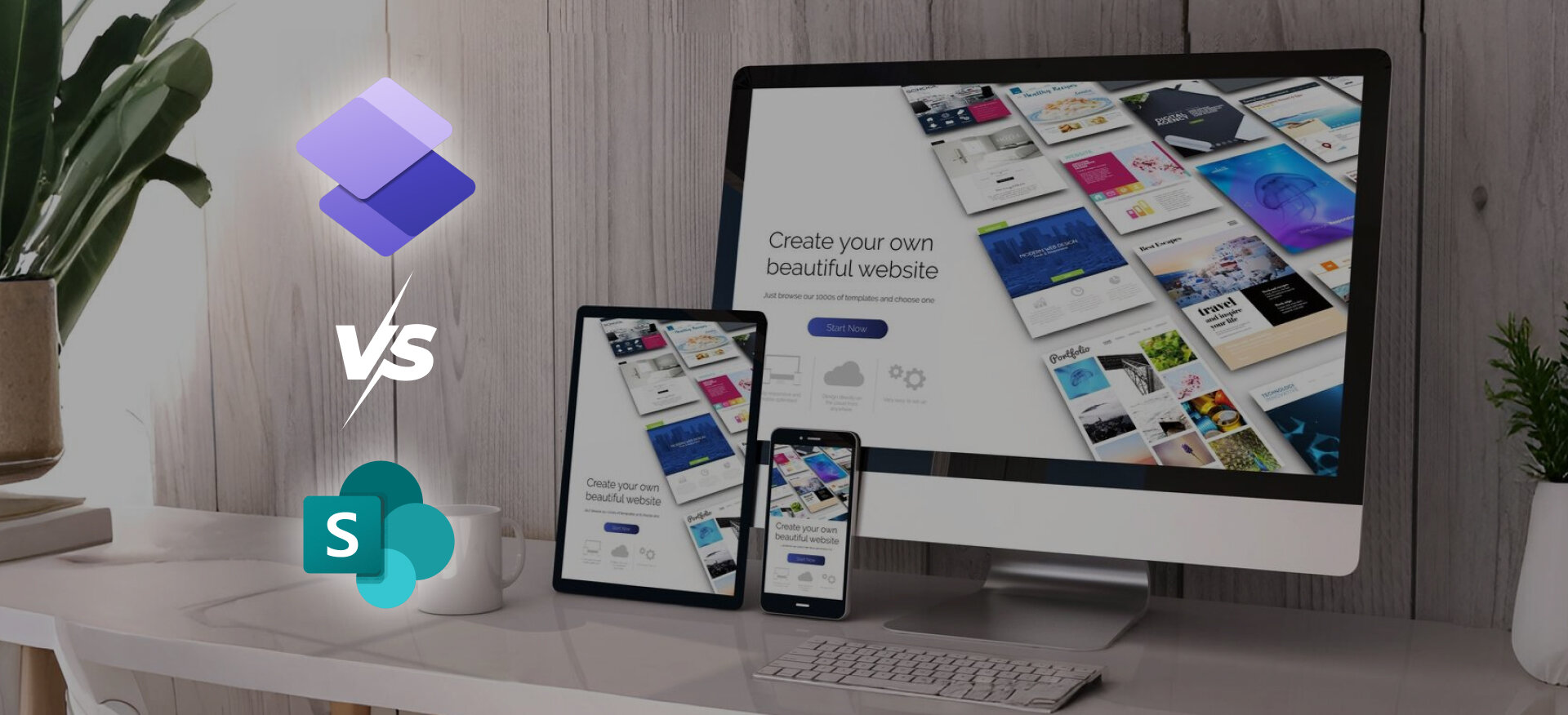So, what is direct marketing really about?
Think of direct marketing as a way for businesses to talk straight to their customers, no middlemen, no long detours. Instead of going through retailers or big ad networks, brands reach out directly through emails, text messages, phone calls, social media, or even old-school mail.
Unlike traditional marketing methods that rely on intermediaries like retailers.
It’s about personal, one-on-one conversations that aim to get people to take action, like buying something, signing up, or asking for more info.
The best part is, it’s measurable and targeted, meaning businesses know exactly who they’re talking to and how well their message works.
With the growth of digital channels, direct marketing has evolved to include online tactics like email marketing campaigns, social media ads, and SMS promotions.
In this blog, we will explore everything about direct marketing and how it helps build stronger relationships with customers and drives sales through precise, targeted communication.
What is Direct Marketing?
Direct marketing is a marketing strategy that involves direct communication with potential customers to promote products or services.
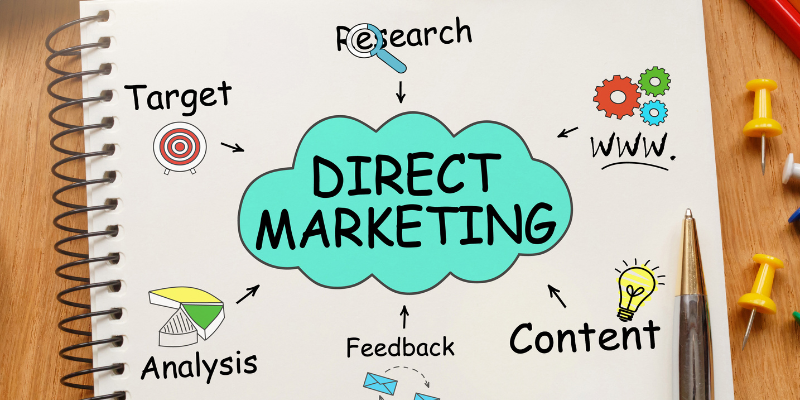
Unlike traditional marketing methods, which rely on intermediaries such as retailers, direct marketing allows businesses to engage with their target audience directly.
In today’s data-driven world, understanding what is the digital marketing strategy that tracks users across the web? helps marketers personalize direct outreach even further, using insights from user behavior to tailor messages effectively.
This interaction is typically through various channels, such as email, direct mail, telemarketing, SMS, or social media, with the goal of generating a measurable response, such as a purchase, subscription, or inquiry.
In today’s fast-paced, highly competitive business environment, direct marketing has become a crucial tool for companies seeking to build strong customer relationships and increase sales.
By focusing on targeted messaging, businesses can reach specific segments of their audience, ensuring that marketing efforts are efficient and cost-effective.
Direct marketing also enables real-time feedback, allowing companies to quickly gauge the effectiveness of their campaigns and make necessary adjustments.
This responsiveness is vital in a market where consumer preferences and trends are constantly evolving.
Explore Our Digital Marketing Services!
5 Common Types of Direct Marketing
It includes email marketing, direct mail, telemarketing, SMS marketing, and social media marketing, each targeting customers directly through personalized communication.
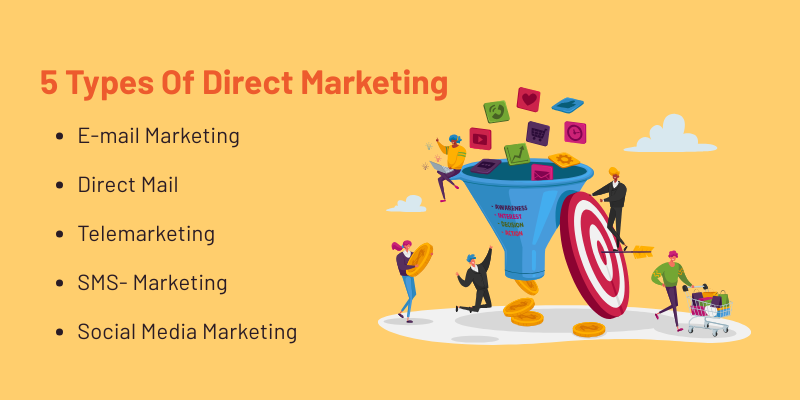
1. Email Marketing
Email marketing involves sending personalized emails directly to consumers with the goal of building relationships, promoting products, or encouraging engagement.
It is a highly effective method due to its low cost, ease of automation, and ability to segment audiences for targeted campaigns.
When integrated with Google keyword ranking insights, email subject lines and content can be optimized to align with trending search terms, increasing visibility and click-through rates.
Successful email marketing campaigns can include newsletters, promotions, product updates, and personalized offers, which help maintain customer interest and drive conversions.
Explore Our Email Marketing Services!
2. Direct Mail
Direct mail refers to the physical sending of promotional materials to a targeted group of consumers, often supported by advertisement examples like flyers, catalogs, or postcards that illustrate the brand’s message.
These materials can include catalogs, brochures, postcards, or personalized letters. Despite the rise of digital communication, direct mail remains effective for certain audiences, particularly older demographics.
Direct mail is known for its tangible, personal touch, which can enhance brand recall and customer loyalty.
3. Telemarketing
Telemarketing is the practice of contacting potential customers via telephone to promote products, services, or gather feedback.
This form of direct marketing allows for real-time interaction with customers, providing an opportunity for immediate responses and building rapport, which even specialized sectors like an oil and gas marketing agency leverage to connect with niche audiences.
It can be inbound (handling customer inquiries) or outbound (initiating calls to potential leads).
Despite some criticism, telemarketing remains valuable in certain industries, such as financial services and B2B sales.
4. SMS Marketing
SMS marketing involves sending text messages to customers' mobile phones, often with time-sensitive promotions, updates, or personalized offers.
It boasts high open rates since text messages are immediately seen by recipients.
SMS marketing is especially effective for businesses that want to reach customers quickly, with short, impactful messages that encourage immediate action, like flash sales or event reminders.
5. Social Media Marketing
Social media marketing utilizes platforms like Facebook, Instagram, LinkedIn, and Twitter to directly engage with consumers.
Through posts, advertisements, and interactive content, businesses can reach a vast audience and foster two-way communication.
Integration with top search engines and social platforms ensures consistent brand visibility across both organic and paid channels.
Social media allows for highly targeted advertising, enabling brands to segment audiences based on interests, demographics, and behavior, resulting in more personalized and effective marketing strategies.
Social media campaigns also facilitate direct customer feedback and community building, which are valuable for long-term customer loyalty.
Top 5 Benefits of Direct Marketing
Now that we understand what is direct marketing, let’s look at its biggest benefits.
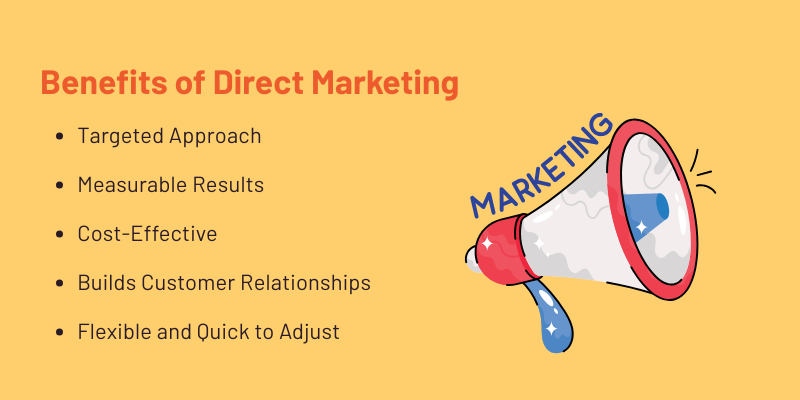
It offers a targeted approach, measurable results, and cost-effectiveness, while also helping build stronger customer relationships and allowing for quick campaign adjustments.
Here are some of the key benefits of direct marketing:
1. Targeted Approach
Direct marketing lets businesses focus on specific customer segments using data like demographics, interests, and buying behavior. This ensures messages reach people most likely to respond, leading to higher engagement and conversion rates.
2. Measurable Results
Every direct marketing effort, from email opens to social media clicks, can be tracked in real-time, helping businesses understand how to measure awareness in marketing while refining campaigns for better outcomes.
This helps businesses understand what’s working, refine campaigns, and improve ROI with data-backed decisions.
Tools like SEO ranking report software can further enhance tracking by providing keyword performance insights that connect search data with campaign metrics, offering a comprehensive view of marketing effectiveness.
3. Cost-Effective
Compared to TV or print ads, direct marketing is budget-friendly. It focuses spending on the right audience and uses affordable channels like email and SMS, making it ideal for small businesses.
4. Builds Customer Relationships
Personalized communication creates a sense of trust and connection. When customers feel seen and understood, they’re more likely to stay loyal and engage with future campaigns.
5. Flexible and Quick to Adjust
Direct marketing allows for rapid testing and changes. If a message or channel isn’t performing well, marketers can tweak it instantly, keeping campaigns fresh and effective.
Creating a Direct Marketing Campaign: Step-by-Step
What is Direct Marketing? Here are some of the steps for creating a campaign include defining objectives, targeting the right audience, selecting channels, and crafting personalized content.
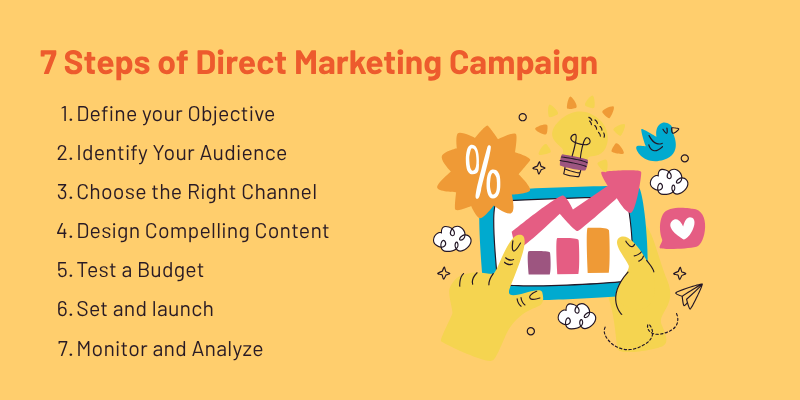
1. Define Your Objective
The first step in any direct marketing campaign is to define what you aim to achieve. Are you trying to increase sales, promote a new product, gather leads, or increase brand awareness? Clearly setting your goals will help shape the rest of the campaign.
2. Identify Your Target Audience
Understanding your audience is crucial. Use data analytics, demographic insights, and behavioral patterns to segment your audience effectively.
Whether it’s age, location, purchasing habits, or interests, segmenting allows you to craft more personalized and relevant messages that will resonate with specific groups.
In some industries, network marketing strategies are also employed to expand audience reach through personal connections and referrals, amplifying the impact of direct campaigns.
3. Choose the Right Channels
Once your audience is segmented, select the channels that align with their preferences, applying performance marketing principles to analyze ROI and optimize ad spend effectively.
For example, younger audiences may engage more with social media or SMS marketing, while older demographics may prefer direct mail or email.
The right channel ensures that your message is received where your target audience is most likely to engage.
4. Design Compelling Content
Your content is the heart of the campaign. Make sure your message is engaging, clear, and includes a compelling call to action.
Personalize your content to appeal to the interests and needs of your audience.
5. Set a Budget
It’s essential to set a realistic budget that aligns with your goals and chosen channels. Consider the cost of producing and sending emails, direct mail, or running paid ads on social media. Allocate your budget in a way that allows you to scale your efforts and optimize the campaign as it progresses.
6. Test and Launch
Before launching the full campaign, consider running A/B tests to determine which message, offer, or subject line resonates best with your audience. This will help you refine your approach before investing in a larger rollout.
7. Monitor and Analyze Results
As your campaign runs, monitor the performance closely. Track metrics such as open rates, click-through rates, conversions, and overall ROI. By analyzing these results, you can gauge how well the campaign is performing and where improvements may be needed.
7 Best Practices For Success
Best practices for success in direct marketing include personalizing messages, using clear calls to action, optimizing for mobile, and respecting privacy regulations.
1. Personalize Your Message
Personalization is key to building stronger connections with your audience. Use customer data to create personalized messages that speak to their individual needs.
2. Use Clear Calls to Action
Every direct marketing piece should have a clear call to action (CTA). Whether it’s “Buy Now,” “Learn More,” or “Sign Up Today,” your CTA should prompt immediate action.
Make sure the CTA is visible, compelling, and easy for the customer to follow.
3. Optimize for Mobile
In today's digital world, most people access content via mobile devices. Ensure that your emails, SMS messages, and landing pages are optimized for mobile viewing.
Mobile-friendly campaigns are more likely to engage users and drive conversions, as they can access the information quickly and easily.
4. Follow Up
Don’t let the first interaction be the last. Follow-up emails or messages can be a great way to increase conversion rates. Following up ensures your message stays top of mind.
5. Respect Privacy
With the rise of data privacy concerns, it's crucial to follow privacy regulations such as GDPR, CCPA, and CAN-SPAM.
Be transparent about how you collect, use, and store customer data. Always give recipients an easy way to opt-out if they no longer wish to receive your messages.
Balancing performance marketing vs brand marketing goals within privacy boundaries ensures compliance while maintaining trust and
6. Keep It Simple
Direct marketing should be clear, concise, and to the point. Avoid overwhelming your audience with excessive information.
Use straightforward language and focus on one key message that encourages the recipient to take action.
Simple, well-crafted messages supported by strong advertisement examples often perform better than overly complex campaigns.
7. Track and Adjust
Regularly monitor your campaign’s performance and be ready to make adjustments if needed.
If something isn’t working whether it’s a specific channel, message, or offer make changes and test again. Continuously optimizing the campaign helps you improve engagement and ROI over time.
Conclusion
Now that you know what is direct marketing, it’s clear that this targeted approach allows businesses to communicate directly with consumers through channels like email, direct mail, and social media.
It offers a personalized, measurable, and cost-effective way to boost engagement and ROI.
In essence, direct marketing helps brands reach specific audiences, track performance, and drive higher conversions.
Yet, it does come with challenges, such as consumer resistance and privacy concerns, that businesses must handle with care.
Looking ahead, direct marketing will continue to evolve with AI and automation, integrating SEO Services and advanced analytics offered by digital transformation agencies like Centric to enable even more personalized and data-driven campaigns.
As privacy laws tighten, staying compliant with data protection regulations will be key to maintaining customer trust and long-term success.





